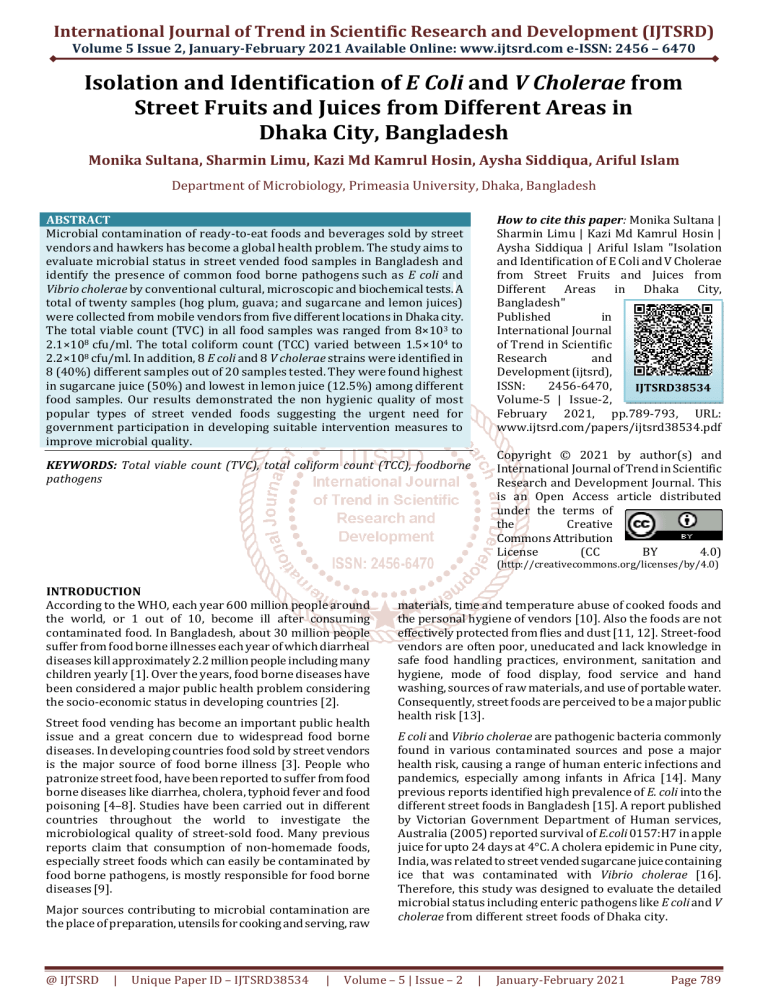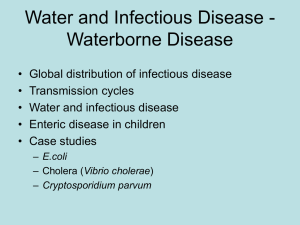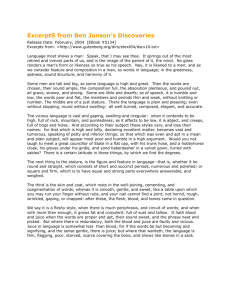
International Journal of Trend in Scientific Research and Development (IJTSRD)
Volume 5 Issue 2, January-February 2021 Available Online: www.ijtsrd.com e-ISSN: 2456 – 6470
Isolation and Identification of E Coli and V Cholerae from
Street Fruits and Juices from Different Areas in
Dhaka City, Bangladesh
Monika Sultana, Sharmin Limu, Kazi Md Kamrul Hosin, Aysha Siddiqua, Ariful Islam
Department of Microbiology, Primeasia University, Dhaka, Bangladesh
How to cite this paper: Monika Sultana |
Sharmin Limu | Kazi Md Kamrul Hosin |
Aysha Siddiqua | Ariful Islam "Isolation
and Identification of E Coli and V Cholerae
from Street Fruits and Juices from
Different Areas in Dhaka City,
Bangladesh"
Published
in
International Journal
of Trend in Scientific
Research
and
Development (ijtsrd),
ISSN:
2456-6470,
IJTSRD38534
Volume-5 | Issue-2,
February 2021, pp.789-793, URL:
www.ijtsrd.com/papers/ijtsrd38534.pdf
ABSTRACT
Microbial contamination of ready-to-eat foods and beverages sold by street
vendors and hawkers has become a global health problem. The study aims to
evaluate microbial status in street vended food samples in Bangladesh and
identify the presence of common food borne pathogens such as E coli and
Vibrio cholerae by conventional cultural, microscopic and biochemical tests. A
total of twenty samples (hog plum, guava; and sugarcane and lemon juices)
were collected from mobile vendors from five different locations in Dhaka city.
The total viable count (TVC) in all food samples was ranged from 8×103 to
2.1×108 cfu/ml. The total coliform count (TCC) varied between 1.5×104 to
2.2×108 cfu/ml. In addition, 8 E coli and 8 V cholerae strains were identified in
8 (40%) different samples out of 20 samples tested. They were found highest
in sugarcane juice (50%) and lowest in lemon juice (12.5%) among different
food samples. Our results demonstrated the non hygienic quality of most
popular types of street vended foods suggesting the urgent need for
government participation in developing suitable intervention measures to
improve microbial quality.
Copyright © 2021 by author(s) and
International Journal of Trend in Scientific
Research and Development Journal. This
is an Open Access article distributed
under the terms of
the
Creative
Commons Attribution
License
(CC
BY
4.0)
KEYWORDS: Total viable count (TVC), total coliform count (TCC), foodborne
pathogens
(http://creativecommons.org/licenses/by/4.0)
INTRODUCTION
According to the WHO, each year 600 million people around
the world, or 1 out of 10, become ill after consuming
contaminated food. In Bangladesh, about 30 million people
suffer from food borne illnesses each year of which diarrheal
diseases kill approximately 2.2 million people including many
children yearly [1]. Over the years, food borne diseases have
been considered a major public health problem considering
the socio-economic status in developing countries [2].
Street food vending has become an important public health
issue and a great concern due to widespread food borne
diseases. In developing countries food sold by street vendors
is the major source of food borne illness [3]. People who
patronize street food, have been reported to suffer from food
borne diseases like diarrhea, cholera, typhoid fever and food
poisoning [4–8]. Studies have been carried out in different
countries throughout the world to investigate the
microbiological quality of street-sold food. Many previous
reports claim that consumption of non-homemade foods,
especially street foods which can easily be contaminated by
food borne pathogens, is mostly responsible for food borne
diseases [9].
Major sources contributing to microbial contamination are
the place of preparation, utensils for cooking and serving, raw
@ IJTSRD
|
Unique Paper ID – IJTSRD38534
|
materials, time and temperature abuse of cooked foods and
the personal hygiene of vendors [10]. Also the foods are not
effectively protected from flies and dust [11, 12]. Street-food
vendors are often poor, uneducated and lack knowledge in
safe food handling practices, environment, sanitation and
hygiene, mode of food display, food service and hand
washing, sources of raw materials, and use of portable water.
Consequently, street foods are perceived to be a major public
health risk [13].
E coli and Vibrio cholerae are pathogenic bacteria commonly
found in various contaminated sources and pose a major
health risk, causing a range of human enteric infections and
pandemics, especially among infants in Africa [14]. Many
previous reports identified high prevalence of E. coli into the
different street foods in Bangladesh [15]. A report published
by Victorian Government Department of Human services,
Australia (2005) reported survival of E.coli 0157:H7 in apple
juice for upto 24 days at 4°C. A cholera epidemic in Pune city,
India, was related to street vended sugarcane juice containing
ice that was contaminated with Vibrio cholerae [16].
Therefore, this study was designed to evaluate the detailed
microbial status including enteric pathogens like E coli and V
cholerae from different street foods of Dhaka city.
Volume – 5 | Issue – 2
|
January-February 2021
Page 789
International Journal of Trend in Scientific Research and Development (IJTSRD) @ www.ijtsrd.com eISSN: 2456-6470
METHODOLOGY
A. Study area and sample collection
Five different areas of Dhaka city were selected as sampling
sites for the investigation such as Uttara, Mohakhali, Mirpur,
Airport and Farmgate. A total of twenty street fruit and juice
samples (S1-S20) were collected from mobile vendors of
these areas, at least 4 samples from each site. Two fruit
samples (guava and hog plum) and juice samples (sugarcane
and lemon) were collected in pre-sterilized stomacher bags
and Duran bottles, kept in ice-boxes. Further, these samples
were transported and analyzed in the laboratory, department
of Microbiology, Primeasia University, Dhaka-1213,
Bangladesh.
B. Enumeration of total viable count (TVC) and total
coliform count (TCC)
Serial dilutions of samples were made up to 10-7 with sterile
normal saline. 1 mL of each homogenate from samples was
added in 9 ml NaCl solution. For the enumeration of total
viable bacteria and coliforms, 0.1 ml of each dilution was
evenly spread on the nutrient agar (NA) medium for total
viable count (TVC) and MacConkey agar for total coliform
count (TCC). Then, the agar plates were incubated at 370C for
24 hours. Plates were screened for the presence of discrete
colonies after incubation period and the actual numbers of
bacteria were estimated as colony forming unit per ml
(cfu/ml).
C. Isolation of enteric pathogens like E coli and Vibrio
cholerae
10 gm of homogenized fruit or 10ml of juice sample was preenriched in 90 ml buffered peptone water (incubated
overnight at 37ºC), followed by enrichment in lactose broth
for E. coli and alkaline peptone water for Vibrio cholerae.
Then the culture media were incubated at 370 c for 24 hours.
For presumptive isolation of E. coli, the enrichment culture
was streaked onto Eosine Methylene Blue (EMB) agar media
and incubated for 24 hours at 37ºC. For Vibrio cholerae
isolation, the enrichment culture was streaked onto
Thiosulfate-Citrate-Bile Salts-Sucrose (TCBS) agar media and
incubated for 24 hours at 37ºC.
D. Biochemical tests
For the biochemical characterization of the isolates, different
tests including Triple Sugar Iron (TSI), Indole, Voges
Proskeur (VP), Methyl red (MR), Motility, H2S production,
Oxidase and Citrate tests were done. D. Biochemical tests
For the biochemical characterization of the isolates, different
tests including Triple Sugar Iron (TSI), Indole, Voges
Proskeur (VP), Methyl red (MR), Motility, H2S production,
Oxidase and Citrate tests were done.
RESULTS
A. Enumeration of total viable count (TVC) and total
coliform count (TCC)
The total viable and coliform count of different street food
samples are given in Table 1. The highest number of bacterial
colony was observed in guava sample (2.1×108cfu/ml)
collected from Mohakhali, the lowest total bacterial count
was found in hog plum (8×103cfu/ml) from Mirpur. The
highest total coliform count was observed in sugarcane juice
(2.2×108 cfu/ml) collected from Farmgate, the lowest count
was 1.5×104 cfu/ml in lemon juice which was collected from
Mohakhali.
B. Isolation of E coli and V cholerae
All the 20 samples were found to be heavily contaminated
with enteric pathogens like E coli and V cholerae. Based on
the rapid biochemical tests (Table 6), the identities of E coli
and V cholerae on different selective media of both fruit and
juice samples were confirmed.
Total 8 E. coli strains (EC1- EC8) were isolated from 8 (40%)
samples out of 20 analyzed in this study (Table 2). E coli
contamination (40%) was observed among sugarcane juice,
lemon juice and guava samples collected from Mohakhali
(12.5%), Uttara (25%), Mirpur (12.5%), Airport (25%) and
Farmgate (25%). Out of 8 positive samples, E coli strains
were isolated from 4 (50%) sugarcane samples, 3 (37.5%)
guava samples and 1(12.5%) lemon juice sample (Table 3).
TABLE 1: Total viable and coliform count from street fruit and juice samples (n=20)
Sample ID Sampling Area Type of Sample TVC (cfu/ml) TCC (cfu/ml)
S1
Hog plum
2×106
8×105
S2
Guava
2.1×108
1.8×108
Mohakhali
S3
Sugarcane Juice 2.4×106
4×107
6
S4
Lemon Juice
2.5×10
1.5×104
7
S5
Hog plum
8×10
4×107
5
S6
Guava
8×10
2.5×106
Uttara
6
S7
Sugarcane Juice 5.5×10
4×105
8
S8
Lemon Juice
1.5×10
0
S9
Hog plum
8×103
0
S10
Guava
8.5×106
0
Mirpur
S11
Sugarcane Juice 1.2×108
5×107
7
S12
Lemon Juice
6×10
1.2×106
5
S13
Hog plum
7×10
0
S14
Guava
1.8×108
1.2×108
Airport
S15
Sugarcane Juice 4×107
1.2×106
S16
Lemon Juice
3×105
3×105
S17
Hog plum
5×107
2.1×104
S18
Guava
1.2×108
5×107
Farmgate
S19
Sugarcane Juice 8×107
2.2×108
S20
Lemon Juice
1.8×106
1.8×104
@ IJTSRD
|
Unique Paper ID – IJTSRD38534
|
Volume – 5 | Issue – 2
|
January-February 2021
Page 790
International Journal of Trend in Scientific Research and Development (IJTSRD) @ www.ijtsrd.com eISSN: 2456-6470
TABLE 2: E. coli strains isolated from different areas in
Dhaka city
Stain ID Types of sample Collection area
EC1
Guava
Mohakhali
EC2
Guava
Uttara
EC3
Sugarcane juice
Uttara
EC4
Sugarcane juice
Mirpur
EC5
Guava
Airport
EC6
Sugarcane Juice
Airport
EC7
Sugarcane juice
Farmgate
EC8
Lemon Juice
Farmgate
TABLE 3: E. coli strains isolated from different street
fruit and juice samples
Similarly, V cholerae was most frequently detected in
different food samples and 8 (40%) samples out of 20 were
found to be V cholerae contaminated (Table 4). Total 8 V.
cholerae strains (VC1- VC8) were found among sugarcane
juice, lemon juice, guava and hog plum samples which were
collected from Mohakhali (25%), Uttara (12.5%), Mirpur
(25%), Airport (12.5%) and Farmgate (25%). The frequency
of V cholerae was found to be highest in sugarcane juice from
4 (50%) samples, followed by guava 2 (25%), lemon juice
and hog plum 1 (12.5%) samples respectively (Table 5).
TABLE 4: V. cholerae strains isolated from different
areas in Dhaka city
Strain ID Types of sample Collection area
VC1
Guava
Mohakhali
VC2
Sugar cane juice
Mohakhali
VC3
Guava
Uttara
VC4
Sugar cane juice
Mirpur
VC5
Lemon juice
Mirpur
VC6
Sugar cane Juice
Airport
VC7
Hog plum
Farmgate
VC8
Sugar cane juice
Farmgate
TABLE 5: V. cholerae strains isolated from different
street fruit and juice samples
@ IJTSRD
|
Unique Paper ID – IJTSRD38534
|
TABLE 6: Biochemical identification of isolated strains
of E. coli and V cholerae results
Isolated strains
Biochemical Tests
E coli V cholerae
Slant
Y
Y
TSI
Butt
Y
Y
Gas
+
_
H S reaction
2
Indole test
+
+
Citrate test
MR test
+
+
VP test
Motility test
+
+
Oxidase test
+
Legend: “+”=positive, “-”=negative, Y=yellow
DISCUSSION
Street foods are prepared, processed and handled in a more
or less quick and casual way by non-professional personnel in
developing countries, like in Bangladesh; tend to be
vulnerable to the possible microbial attacks propagated from
the surrounding environment. Therefore, the current study
attempted to check the presence of pathogenic
microorganisms in terms of total viable and coliform count as
well as in the finding of two enteric pathogens such as Vibrio
cholerae and E coli in various street foods which are being
sold and prepared by various vendors in Dhaka city,
Bangladesh.
This result highlights the fact that the prevalence of bacterial
colony was highest in guava sample (2.1×108cfu/ml) which is
higher than 2.1×104 CFU/ml in guava sample observed by
Baishakhi et al. in Bangladesh [17]. Another major finding of
the study was that the total coliform count was highest in
sugarcane juice (2.2×108 cfu/ml) collected from Farm gate
whereas Rashed et al. stated that the highest coliform count
for vendor fruit juice was 1.58 x106 cfu/ml collected from
Farmgate [18].
There are several reports of illnesses due to the food borne
diseases associated with the consumption of fruit juices at
several places around the globe [19-21]. In the present study,
40% (8/20) food samples were found as E. coli and V cholerae
positive. This finding is consistent with a previous study
conducted by Singh et al. in 2016 in India where eight food
samples out of 26 were found positive for E. coli showing
30.7% overall incidence [22]. Another study was conducted
in Korea where E. coli was most frequently detected in
convenient foods and 50% samples were found to be E. coli
contaminated [23]. As the presence of coliforms and E. coli in
food may indicate fecal contamination, presence of E. coli in
40% street food samples might be representing fecal
contamination in the present study.
Vibrio cholerae has long been known to be responsible for the
life threatening secretory diarrhoea termed as Asiatic cholera
or epidemic cholera [24, 25]. Although cholera is primarily
known as a waterborne disease in the endemic regions
including Bangladesh, contamination of foods can also be an
imperative mode for cholera transmission [26]. Upon
analysis, the prevalence of V. cholerae in food samples was
40% in our study which is in agreement with another study
demonstrated by Ubong et al. where the prevalence of V
cholerae in fruit juices and flavored drinks for hawker stalls
was 36.7% [27].
Volume – 5 | Issue – 2
|
January-February 2021
Page 791
International Journal of Trend in Scientific Research and Development (IJTSRD) @ www.ijtsrd.com eISSN: 2456-6470
The frequency of E. coli and V cholerae was found to be
highest in sugarcane juice (50%) in our study. This may
result from the presence of microorganisms on the sugarcane
that are introduced into the juices during processing [28, 29].
The most frequently isolated enteric bacteria such as E. coli
(n=9; 36%) from sugarcane juices was also found by
MWAMBETE in Tanzania [30]. In this study, the distribution
percentages of E. coli and Vibrio cholerae in guava were
37.5% and 25%, which are higher than the findings of Sarker
et al. [31], i.e. the frequency distribution of E. coli was 22.64%
and Vibrio spp. was 16.03%.
CONCLUSION
Current study exhibited the microbiological status of
available local fruits and juices to ensure food safety for a
precise control over public health risk. We observed high
prevalence of enteric pathogens among the street foods in
different areas of Dhaka city. Lack of awareness and lack of
adherence to the food laws and regulation together within
the frequent implementation of existing regulations are
contributing significantly to dissatisfactory food safety
circumstances of Bangladesh. We call upon the regulatory
authorities to re-enforce measures on microbiological food
safety in processing of ready-to-eat foodstuffs.
Acknowledgment
We would like to thank Dr Suvamoy Datta, Professor and
Head of the department and also the lab members of the
department of Microbiology, Primeasia University, Dhaka,
Bangladesh for their constant support.
References
[1] Baker KK et al. 2016. Sanitation and Hygiene-Specific
Risk Factors for Moderate-to-Severe Diarrhea in
Young Children in the Global Enteric Multicenter
Study, 2007-2011: Case-Control Study. PLoS Med. 13:
e1002010.
[2]
Ma L, Chen H, Yan H, Yang L and Wu L. 2017. Multiple
attribute decision making model and application to
food safety risk evaluation. PLoS One. 12: e0189835.
[3]
Kibret M, Tadesse M. The bacteriological safety and
antimicrobial susceptibility of bacteria isolated from
street-vended white lupin (Lupinus albus) in Bahir
Dar, Ethiopia. Ethiop J Health Sci 2013; 23: 19-26.
[4]
Bean NH, Griffin PM, Goulding JS, Ivey CB. Foodborne
disease outbreak, a five-year summary 1983–1987. J
Food Prot. 1990; 53:816–826.
[5]
Desenclos JCA, Klontz KC, Wolfe LE, Hoecheri S. The
risk of Vibrio illness in the Florida raw oyster eating
population 1981–1988. Am J Epidemiol. 1991; 134:
290–297.
[6]
Kaul M, Agarwal G. Microbial load of common chat
products. Indian J Nutr Diet. 1988; 25:197–199.
[7]
Rodrigue DC, Tauxe RV, Rowe B. International
increase
in Salmonella
enteritidis:
a
new
pandemic. Epidemiol Infect. 1990; 10: 21–27. doi:
10.1017/S0950268800047609.
[8]
Todd ECD. Foodborne disease in Canada—a 10-year
summary from 1975 to 1984. J Food Prot. 1992; 55:
123–132.
[9]
Greksa LP, Islam A, Okamoto R and Omori K. 2017.
Dietary Patterns and Dietary Adequacy of Street
@ IJTSRD
|
Unique Paper ID – IJTSRD38534
|
Children in Dhaka, Bangladesh. Eco.l Food Nutr. 56:
479-492.
[10]
Sharmila Rane. Street vended food in developing
world: hazard analyses. Indian J Microbial, (2011)
51(1):100-6. doi: 10.1007/s12088-011-0154-x.
[11]
C. Dardano, “Carribbean regional working group on
street food vendors,” Report of FAO, PAHO and BNSI,
2003, ftp:ftp.fao.org/es/esn/food/carribean_report.p
df.
[12]
C. Muyanja, L. Nayiga, N. Brenda, and G. Nasinyama,
“Practices, knowledge and risk factors of street food
vendors in Uganda,” Food Control, vol. 22, no. 10, pp.
1551–1558, 2011.
[13]
S. Bhowmik, Street Vendors in the Global Urban
Economy, Routledge: Taylor & Francis, New Delhi,
India, 2010.
[14]
Ademola O. Olaniran*, Kovashnee Naicker
Balakrishna Pillay. Toxigenic Escherichia coli
Vibrio cholerae: Classification, pathogenesis
virulence determinants (2011). Biotechnology
Molecular Biology Review Vol. 6(4), pp. 94-100.
[15]
Islam MA, Mondol AS, Azmi IJ, de Boer E, Beumer RR,
Zwietering MH, Heuvelink AE and Talukder KA. 2010.
Occurrence and characterization of Shiga toxinproducing Escherichia coli in raw meat, raw milk, and
street vended juices in Bangladesh. Food borne
Pathog. Dis. 7: 1381-5.
[16]
Mosupye FM and von Holy A. 1999. Microbiological
Quality and Safety of Ready-To-Eat Street Vended
Foods in Johannesburg, South Africa. Journal for Food
Protection. 1278-1284.
[17]
Baishakhi Biswas et al. 2020. Isolation and
Identification of Pathogenic Bacteria from Fresh
Fruits and Vegetables in Chittagong, Bangladesh.
Journal of Microbiology Research, 10(2): 55-58
[18]
Rashed et al. 2003. Microbiological study of vendor
and packed fruit juices locally available in Dhaka city,
Bangladesh. International Food Research Journal
20(2):
1011-1015.
Journal
homepage:
http://www.ifrj.upm.edu.my
[19]
Mosupye, F. M. and Holy, A. V. 2000. Microbiological
hazard identification and exposure assessment of
street food vending in Johannesburg, South Africa.
Inernational Journal of Food Microbiology 61: 137145.
[20]
Muinde, O. K. and Kuria, E. 2005. Hygienic and
sanitary practices of vendors of street foods in
Nairobi, Kenya. African journal of Food Agriculture
and Nutritional Development 5 (1): 1-13.
[21]
Chumber, S. K., Kaushik, K. and Savy, S. 2007.
Bacteriological analysis of street foods in Pune, Indian
Journal of Public Health 51 (2): 114-116.
[22]
Namita Ashish Singh and Jitesh Saxena, 2016
Evaluation of E. coli bacteria in different food
samples. International Journal on Life science and
Bioengineering, 3:1.
[23]
Chung M, Kim C, Ha S. 2010. Detection and
enumeration of microorganisms in ready-to-eat foods,
Volume – 5 | Issue – 2
|
January-February 2021
and
and
and
and
Page 792
International Journal of Trend in Scientific Research and Development (IJTSRD) @ www.ijtsrd.com eISSN: 2456-6470
ready-to-cook foods and fresh-cut produce in Korea. J
Food
Safety
30(2),
480-489.
http://dx.doi:10.1111/j.1745-4565.2010.00221.x
[24]
Ryan, K. J. and Ray, C. G. 2004. Sherris Medical
Microbiology. 4th eds. McGraw Hill. ISBN
0838585299.
[25]
Faruque, S. M. and Nair, G. B. 2008. Vibrio cholerae:
Genomics and Molecular Biology. Caister. Academic
Press. ISBN 978-1-904455-33-2.
[26]
Glass, R. I. and Black R. E. 1992. The epidemiology of
cholera. In Barua, D. and Greenough, W. B. (Eds.).
Cholera, p. 129-154. New York: Plenum.
[27]
Ubong et al. (2011). Prevalence and detection of
Vibrio spp. and Vibrio cholerae in fruit juices and
flavored drinks. International Food Research Journal
18(3): 1163-1169.
@ IJTSRD
|
Unique Paper ID – IJTSRD38534
|
[28]
K. R. Aneja, R. Dhiman, N. K. Aggarwal, V. Kumar and
M. Kaur. Int. J. Food Sci. 2014, 2014.
[29]
V. H. Tournas, J. Heeres, and L. Burgess. Food
Microbiol. 23(7), 2006, 684-688.
[30]
K. D. MWAMBETE1 and M. H. MPENDA (2019).
Microbiological Quality of Freshly Squeezed Sugarcane Juices Vended in Dar es Salaam, Tanzania. East
and Central African Journal of Pharmaceutical
Sciences Vol. 22: 64-70
[31]
Sarker et al. (2018). Isolation and identification of
bacteria from fresh guava (Psidium guajava) sold at
local markets in Mymensingh and their antibiogram
profile. Veterinary World, EISSN: 2231-0916,
Available
at
www.veterinaryworld.org/Vol.11/August2018/19.pdf
Volume – 5 | Issue – 2
|
January-February 2021
Page 793






